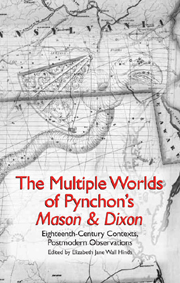 The Multiple Worlds of Pynchon's 'Mason and Dixon'
The Multiple Worlds of Pynchon's 'Mason and Dixon' from Enlightenment Microhistories
Published online by Cambridge University Press: 12 September 2012
For if the dead rise not, then is not Christ raised: And if Christ be not raised, your faith is vain; ye are yet in your sins. Then they also which are fallen asleep in Christ are perished. If in this life only we have hope in Christ, we are of all men most miserable.
— I Corinthians 15:16–19 (KJV)These times are unfriendly toward Worlds alternative to this one.
— Revd Cherrycoke, in Mason & Dixon (359)What?
— John Calvin, InstitutesJUST BEFORE PUBLICATION OF Mason & Dixon, Thomas Pynchon wrote a review of Gabriel Garcia Marquez's Love in the Time of Cholera, in which he says that “to assert the resurrection of the body [is] today as throughout history an unavoidably revolutionary idea” (“Heart's Eternal Vow”). In other essays, such as “Is it OK to be a Luddite?,” Pynchon almost defensively asserts that he is not being “Insufficiently Serious” in his ecomiums to “violations of the laws of nature,” especially “the big one, mortality itself.” Again, in “The Deadly Sins/Sloth,” he risks accusations of naïve historical nostalgia by recalling for us “the long-ago age of faith and miracle, when daily life really was the Holy Ghost visibly at work and time was a story, with a beginning, middle and end. Belief was intense, engagement deep and fatal.”
To save this book to your Kindle, first ensure [email protected] is added to your Approved Personal Document E-mail List under your Personal Document Settings on the Manage Your Content and Devices page of your Amazon account. Then enter the ‘name’ part of your Kindle email address below. Find out more about saving to your Kindle.
Note you can select to save to either the @free.kindle.com or @kindle.com variations. ‘@free.kindle.com’ emails are free but can only be saved to your device when it is connected to wi-fi. ‘@kindle.com’ emails can be delivered even when you are not connected to wi-fi, but note that service fees apply.
Find out more about the Kindle Personal Document Service.
To save content items to your account, please confirm that you agree to abide by our usage policies. If this is the first time you use this feature, you will be asked to authorise Cambridge Core to connect with your account. Find out more about saving content to Dropbox.
To save content items to your account, please confirm that you agree to abide by our usage policies. If this is the first time you use this feature, you will be asked to authorise Cambridge Core to connect with your account. Find out more about saving content to Google Drive.